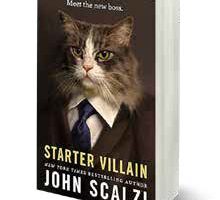I will not reveal the narrator of this illustrious book; but, by Page 2, the following sentences will leave little doubt as to its identity. ìIt suffices to say that at some point in time, I will be standing over you, as genially as possible. Your soul will be in my arms. A color will be perched on my shoulder. I will carry you gently away.î Colors appear to be the only stress reliever for this entity, who works overtime whenever human actions lead to chaos. It attempts to enjoy the entire spectrum of colors, but truly favors ìdark, dark, chocolate.î Creating an exceptional novel takes above-average writing skills, which you will certainly find in ìThe Book Thief.î Placing the book in a grim setting, Germany, 1939, with all its horrors, only compounds that task. Author Markus Zusak overcomes these obstacles with mystical prose and a strong protagonist, 9-year-old Liesel Meminger. She is a blameless victim of the war – Zusakís representative for millions of other innocents who fell prey to Hitlerís madness. The narratorís first encounter with Liesel was on a train traveling to Munich. She and her younger brother, Werner, are being sent to a foster home because their mother could not afford to feed or educate them properly. Werner dies before the trip is over, and is buried in an unnamed town. On the ground beside his grave, Liesel spots a book that she quickly picks up and hides. ìThe Grave Diggerís Handbookî will become the only tangible connection to her past life. Separated from her mother, Liesel is driven to the village of Molching. There, she meets her foster parents, Rosa and Hans Hubermann. They live on Himmel (German for heaven) Street, an ironic name the narrator tells us, since the street bears absolutely no resemblance to paradise. Rosa appears to be a cruel and vindictive woman, who enjoys meting out discipline with a wooden spoon. Her language is crude, causing her to lose some laundry customers because they cannot tolerate her caustic disposition. Hans, however, is a compassionate man, who loves to play the accordion. He reads to Liesel to help alleviate the nightmares that haunt her. He is a house painter by trade – the only thing he has in common with the F¸hrer. Having fought in World War I, he has no illusions about the ìMaster Race.î And itís a promise he made during that war, which brings a stranger to reside in his basement, putting his entire family in jeopardy. While the future doesnít look bright for Liesel, she adapts well to her new situation, playing soccer with the local children and attending school. But her inability to read means sheís subjected to the taunts of her classmates; however, one skinny little boy comes to her rescue, Rudy Steiner. He loves to run and idolizes Jesse Owens, the Olympic champion whose accomplishments embarrassed Hitler during the 1936 games. Liesel also takes over the job of picking up and delivering laundry for Rosa. When she comes to the mayorís home, she is greeted by a sad looking woman. Peering inside the home, she encounters the most amazing sight she has ever seen: a library stuffed with cases of books. Entering the room, she runs from rack to rack, touching as many of the books as possible. As the war progresses, Rudy and Liesel become partners in crime, stealing apples from orchards outside of town. Thatís understandable, especially since the main source of food in Lieselís home consists of pea soup, but she takes the activity a step further. As Rudy stands guard outside, she shimmies through a window into the mayorís library, stealing one book each time. In between these childhood activities, the narrator keeps readers abreast of the progress of the war. ìThe color of Europe is gray,î it informs us, an apt description for a continent besieged by war. Destruction, food shortages, Jews being marched through the streets of Molching on their way to Dachau, are all part of the story. Yet, during all of this, Lieselís education progresses. Using Hansí paint, she writes words she is unfamiliar with on the basement walls. When air raids become a common event in the village, she grabs a book before running to the shelter. There, she reads out loud, which helps to soothe her neighborsí nerves. Zusak wrote ìThe Book Thiefî for young adults, and I canít think of a better book to evoke their interest in history. In addition, they will learn the dangers of idolizing political leaders, how the ìHitler Youthî program ensured the propagation of hate, and why they must be concerned any time a person or organization decides to start burning books. But I think this impressive novel shouldnít be limited to the young adult audience. World War II began 77 years ago; few eyewitnesses are left to remind us how one fanatic can bring the world to its knees. ìThe Book Thiefî delivers that message – in brilliant colors and poetic grace.






